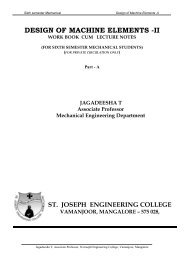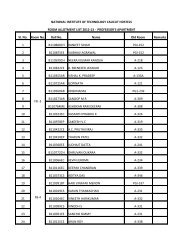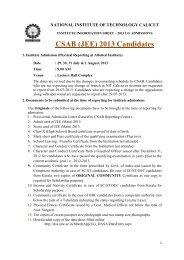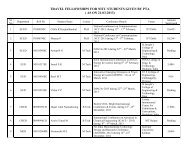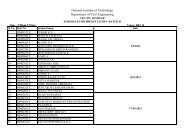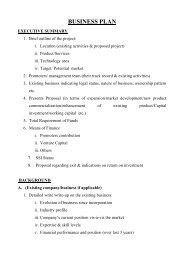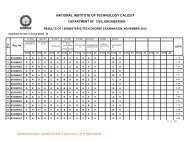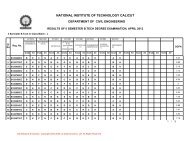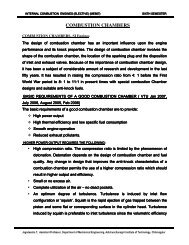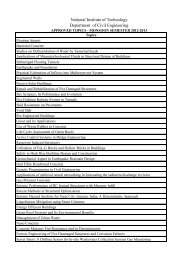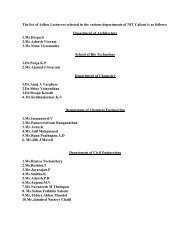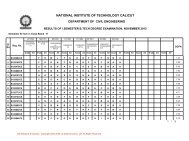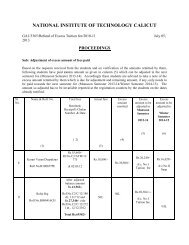combustion process in si engines - National Institute of Technology
combustion process in si engines - National Institute of Technology
combustion process in si engines - National Institute of Technology
Create successful ePaper yourself
Turn your PDF publications into a flip-book with our unique Google optimized e-Paper software.
INTERNAL COMBUSTION ENGINES (ELECTIVE) (ME667)<br />
SIXTH SEMESTER<br />
Eng<strong>in</strong>e Size<br />
Eng<strong>in</strong>es <strong>of</strong> <strong>si</strong>milar de<strong>si</strong>gn generally run at the same piston speed. This is achieved by<br />
us<strong>in</strong>g small eng<strong>in</strong>es hav<strong>in</strong>g larger RPM and larger eng<strong>in</strong>es hav<strong>in</strong>g smaller RPM. Due<br />
to same piston speed, the <strong>in</strong>let velocity, degree <strong>of</strong> turbulence and flame speed are<br />
nearly same <strong>in</strong> <strong>si</strong>milar eng<strong>in</strong>es regardless <strong>of</strong> the <strong>si</strong>ze. However, <strong>in</strong> small eng<strong>in</strong>es the<br />
flame travel is small and <strong>in</strong> large eng<strong>in</strong>es large. Therefore, if the eng<strong>in</strong>e <strong>si</strong>ze is doubled<br />
the time required for propagation <strong>of</strong> flame through <strong>combustion</strong> space is also doubled.<br />
But with lower RPM <strong>of</strong> large eng<strong>in</strong>es the time for flame propagation <strong>in</strong> terms <strong>of</strong> crank<br />
would be nearly same as <strong>in</strong> small eng<strong>in</strong>es. In other words, the number <strong>of</strong> crank degrees<br />
required for flame travel will be about the same irrespective <strong>of</strong> eng<strong>in</strong>e <strong>si</strong>ze provided the<br />
eng<strong>in</strong>es are <strong>si</strong>milar.<br />
5. . Other Factors. Among the other factors, the factors which <strong>in</strong>crease the flame speed<br />
are supercharg<strong>in</strong>g <strong>of</strong> the eng<strong>in</strong>e, spark tim<strong>in</strong>g and re<strong>si</strong>dual gases left <strong>in</strong> the eng<strong>in</strong>e at<br />
the end <strong>of</strong> exhaust stroke. The air humidity also affects the flame velocity but its exact<br />
effect is not known. Anyhow, its effect is not large compared with A :F ratio and<br />
turbulence.<br />
PHENOMENON OF KNOCKING IN SI<br />
ENGINE<br />
(VTU July06/Jan 07)<br />
Knock<strong>in</strong>g is due to auto ignition <strong>of</strong> end<br />
portion <strong>of</strong> unburned charge<br />
<strong>in</strong><br />
<strong>combustion</strong> chamber. As the normal<br />
flame proceeds across the chamber,<br />
pressure and temperature <strong>of</strong> unburned<br />
charge <strong>in</strong>crease due to compres<strong>si</strong>on by<br />
burned portion <strong>of</strong> charge. This unburned<br />
compressed charge may auto ignite<br />
under certa<strong>in</strong> temperature condition and<br />
release the energy at a very rapid rate<br />
compared to normal <strong>combustion</strong><br />
Jagadeesha T, As<strong>si</strong>stant Pr<strong>of</strong>essor, Department <strong>of</strong> Mechanical Eng<strong>in</strong>eer<strong>in</strong>g, Adichunchanagiri <strong>Institute</strong> <strong>of</strong> <strong>Technology</strong>, Chikmagalur



